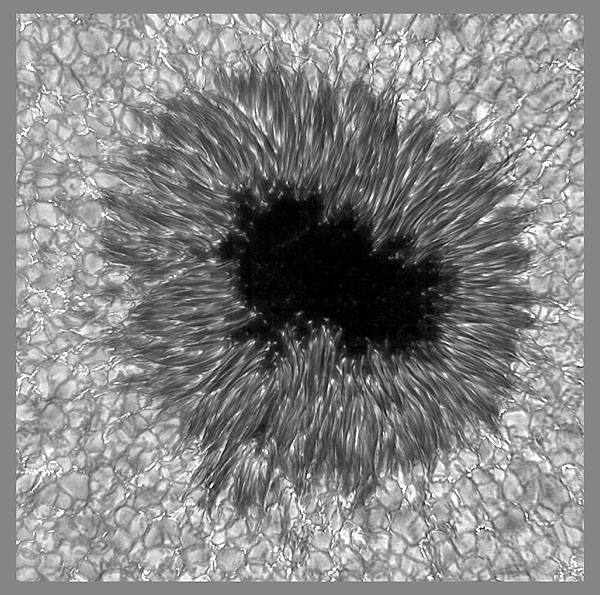
home •
about •
essential guide •
picture of the day •
thunderblogs •
news •
multimedia •
predictions •
products •
get involved •
contact
picture of the day archive subject index
Credit: Mandatory credit: Friedrich Woeger, KIS,
and Chris Berst and Mark Komsa, NSO/AURA/NSF.
Feb 22, 2007
Electric Sunspots
Conventional theorists look to magnetism to solve the problem of solar energy distribution. If they were to open their eyes to the electrical cause of magnetism, the solution would suddenly become visible.This recent image of a sunspot utilized an advance in adaptive optics that enables ground-based telescopes to detect fine details that previously only space telescopes could detect. The announcement of this technical feat included this conventional theoretical interpretation:
“The dark cores of penumbral fibrils and bright penumbral grains are seen as well in the sunspot penumbra (the fluted structures radiating outward from the spot). These features hold the key to understanding the magnetic structure of sunspots and can only be seen in ultra high-resolution images such as this one. Magnetism in solar activity is the ‘dark energy problem’ being tackled in solar physics today.”
The problem is dark to conventional solar physicists because they shut their eyes to the fundamental law that magnetism is the result of electric currents. Seeing the difference between gas (which does not contain free charged particles and is electrically inactive) and plasma (which does contain free charged particles and can be electrically very active) admits the first glimmer of illumination on the problem: Sunspots are not the result of convection of gas modified by magnetism. Sunspots are electrical structures.
To understand why penumbral “fibrils” have dark cores, one must see that they also have a twisted structure that maintains a fairly constant diameter over great distances. They resemble glowing tornadoes. This is the structure of a “charge sheath vortex”: Rapidly rotating charged particles generate strong electric and magnetic fields. The charged particles are concentrated in a thin skin, or “double layer”, at the periphery and their motion is stretched out into a spiral. If the vortex has enough energy to glow, as it does on the Sun, the edges will appear brighter.
Of course, a sunspot is only a tiny part of the much larger phenomenon of the Sun. If the spot is electrical, so must be the entire Sun. Hence to see electricity in any part of the cosmos is to see that all current astrophysical theories are “in the dark”. The technical proficiency of space programs and new instruments is discovering a flood of surprising data about the effects of plasma in space. But progress in understanding this data is vitiated by a theoretical parasitism of obsolete ideas.
__________________________________________________________________________Please visit our Forum
The Electric Sky and The Electric Universe available now!

|
|

|
EXECUTIVE EDITORS:
David Talbott, Wallace Thornhill
MANAGING EDITORS:
Steve Smith, Mel Acheson
CONTRIBUTING EDITORS: Michael Armstrong, Dwardu Cardona,
Ev Cochrane,
C.J. Ransom, Don Scott, Rens van der Sluijs, Ian Tresman
WEBMASTER: Brian Talbott
Copyright 2007: thunderbolts.info
![]()
home •
thunderblogs •
forum •
picture of the day •
resources •
team •
updates •
contact us

